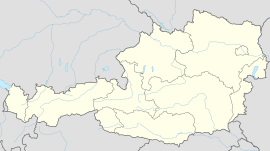Stams facts for kids
Quick facts for kids
Stams
|
||
|---|---|---|

Stams Abbey
|
||
|
||
| Country | Austria | |
| State | Tyrol | |
| District | Imst | |
| Area | ||
| • Total | 33.56 km2 (12.96 sq mi) | |
| Elevation | 672 m (2,205 ft) | |
| Time zone | UTC+1 (CET) | |
| • Summer (DST) | UTC+2 (CEST) | |
| Postal code |
6422
|
|
| Area code | 05263 | |
| Vehicle registration | IM | |
| Website | www.stams.co.at | |
Stams is a small town, called a municipality, in the Imst District of Tyrol, Austria. It's most famous for the beautiful Cistercian Stams Abbey, also known as Stift Stams. This important abbey was started in 1273 by Count Meinhard II of Gorizia-Tyrol and his wife.
Contents
Exploring Stams: Location and People
Stams is found on the south side of the Inn River. It's about 18.5 kilometers (11.5 miles) east of Imst. The town is also 7 kilometers (4.3 miles) west of Telfs. The state capital, Innsbruck, is about 46 kilometers (28.6 miles) to the west.
The village of Stams has around 1300 people living there. These residents are spread out in different areas. Some of these areas include Thannrain, Windfang, Staudach, Haslach, Maehmoos, and Hauland.
A Look Back: History of Stams
Archaeologists have found signs that a church existed in Stams around the year 700 AD. The area was first mentioned in a document from 1063. At that time, it was part of the Duchy of Bavaria. Later, it became a property of the Counts of Tyrol.
Founding of Stams Abbey
Count Meinhard II of Gorizia became the ruler of Tyrol in 1271. He and his wife, Elisabeth of Bavaria, decided to build a special monastery. This monastery was for the Cistercian monks. The first monks came from Kaisheim Abbey in Swabia.
The abbey quickly became a very important spiritual center. It received large areas of land in places like Silz, Meran, and Mals.
Burial Place for Important Figures
Stams Abbey became the final resting place for many important people. Count Meinhard and his wife were buried there. His son, Duke Henry of Carinthia, was also buried at the abbey.
Later, members of the House of Habsburg were buried here. These included Duke Frederick IV of Austria and his wife. Archduke Sigismund of Austria and his wife were also buried there. Even Bianca Maria Sforza, who was the second wife of Emperor Maximilian I, found her resting place at Stams.
Changes Over Time
During the 1500s, the monastery faced difficult times. The community of monks became smaller. In 1552, the abbey was attacked and robbed by soldiers. Even some graves were destroyed.
Starting in the early 1600s, the monastery was rebuilt. It was given its current beautiful Baroque style. This included amazing stucco work by Franz Xaver Feuchtmayer.
Modern History and Education
In 1807, the abbey was temporarily closed by King Maximilian I Joseph of Bavaria. However, it was reopened in 1816 when Stams became part of the Austrian Empire again.
The abbey was closed once more in 1938 by the Nazi German authorities. But after World War II, Cistercian monks returned. They started several schools and educational places. These include the Skigymnasium Stams, which is a special ski boarding school. They also established the Kirchliche Pädagogische Hochschule – Edith Stein school of education and the Meinhardinum gymnasium.
In 1984, Pope John Paul II gave the abbey church the special title of a minor basilica.
Population Growth
The number of people living in Stams has changed over the years. Here's how the population has grown:
| Historical population | ||
|---|---|---|
| Year | Pop. | ±% |
| 1869 | 599 | — |
| 1880 | 565 | −5.7% |
| 1890 | 485 | −14.2% |
| 1900 | 496 | +2.3% |
| 1910 | 561 | +13.1% |
| 1923 | 543 | −3.2% |
| 1934 | 635 | +16.9% |
| 1939 | 628 | −1.1% |
| 1951 | 813 | +29.5% |
| 1961 | 1,008 | +24.0% |
| 1971 | 1,054 | +4.6% |
| 1981 | 1,037 | −1.6% |
| 1991 | 1,183 | +14.1% |
| 2001 | 1,261 | +6.6% |
| 2011 | 1,335 | +5.9% |
Image gallery
Sister Cities: Stams and Kaisheim
Stams has a special connection with another town. This is called a twin town relationship.
See also
 In Spanish: Stams para niños
In Spanish: Stams para niños








